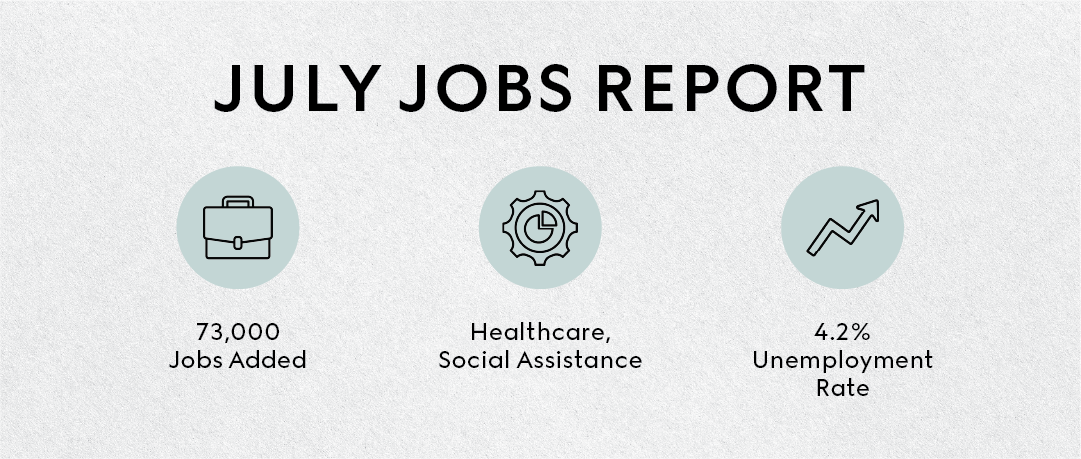July 2025 Jobs Report: The Latest Employment Trends

The latest job report for July provides a comprehensive overview of the current state of employment in the United States.
July’s Key Findings
The U.S. Bureau of Labor Statistics reported that only 73,000 jobs were added in July, marking a notable slowdown in hiring. This continues the trend of modest job growth since April and falls well below the 12-month average of 146,000 jobs. Despite this slowdown, the unemployment rate remained steady at 4.2%, indicating a stable labor market.
Key sectors include:
- Healthcare
- Social Assistance

Sector-Specific Employment Changes
Employment trends in July 2025 varied across sectors, with healthcare and social assistance continuing to show growth, while the federal government sustained further job losses.
Healthcare
Healthcare led this month’s job growth with a gain of 55,000 jobs, outperforming its 12-month average of 42,000 jobs. Ambulatory healthcare services saw the largest increase (+34,000 jobs), followed by hospitals (+16,000 jobs), indicating sustained demand in core medical services.
Social Assistance
Social assistance added 18,000 jobs in July, maintaining a steady upward trend. Notably, individual and family services drove nearly all this growth with an increase of 21,000 jobs, highlighting persistent community and family-level needs.
Other Sectors
Federal government employment declined again in July, losing 12,000 jobs. This brings the cumulative job loss in the sector to 84,000 jobs since its peak in January 2025. Other key industries, including construction, manufacturing, retail, financial activities, leisure and hospitality, and professional services, saw little to no change during the month.
Unemployment Rates
The national unemployment rate remained unchanged at 4.2%, where it has hovered since May 2024. The number of unemployed individuals stood at 7.2 million.
Unemployment rates by demographic group:
- Adult men: 4.0%
- Adult women: 3.7%
- Teenagers: 15.2%
- White population: 3.7%
- Black population: 7.2%
- Asian population: 3.9%
- Hispanic population: 5.0%
New entrants to the labor force, those seeking employment for the first time, increased significantly by 275,000, reaching a total of 985,000. Long-term unemployment (those out of work for 27 weeks or more) also rose by 179,000 to 1.8 million, accounting for 24.9% of all unemployed individuals.
The labor force participation rate held at 62.2%, but is down 0.5 percentage points from a year ago. Similarly, the employment-population ratio remained at 59.6%, down 0.4 percentage points year-over-year. Part-time employment for economic reasons was little changed at 4.7 million.
The number of discouraged workers, those not actively seeking jobs due to the belief that none are available, fell by 212,000 to 425,000, reversing a jump seen the previous month.
Wage Growth & Average Workweek
Wages continued to rise in July, reflecting ongoing income growth for workers:
- Average hourly earnings for all employees on private nonfarm payrolls increased by 0.3% (12 cents) to $36.44.
- Over the past year, hourly wages have grown by 3.9%, consistent with recent trends.
- For private-sector production and nonsupervisory employees, hourly earnings rose by 8 cents (0.3%) to $31.34.
The average workweek edged up by 0.1 hour to 34.3 hours. In manufacturing, employees averaged 40.1 hours, with overtime slightly declining to 2.8 hours. For production and nonsupervisory workers, the workweek also rose by 0.1 hour to 33.7 hours.
Updates to Prior Months’ Employment Data
Significant downward revisions were made to the employment figures for May and June:
- May 2025: Revised down by 125,000 jobs (from +144,000 to +19,000).
- June 2025: Revised down by 133,000 jobs (from +147,000 to +14,000).
These adjustments result in a combined downward revision of 258,000 jobs across the two months. As always, such revisions are based on updated data from employers and seasonal recalculations, underscoring the need to view initial estimates cautiously.
For further reading, check out our other blogs on topics related to the job market.
Are you looking for top talent? Reach out to us today to get started.
Looking for your next career change? Explore our open jobs today.
Get the latest updates and exclusive content – subscribe to our newsletter!
Partner with Premier today.
Where in striving to do better, we transform lives in shared partnership with our exceptional employer and talent communities.



